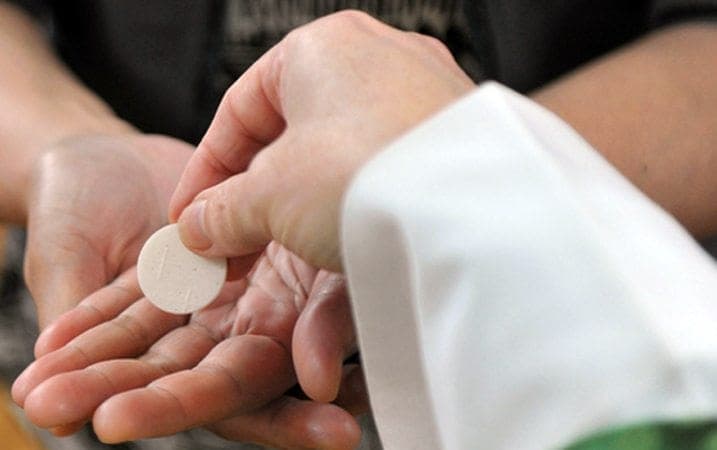What is it about Communion in the hand versus Communion on the tongue?
I’ve been in a lot of Catholic contexts, and nothing — apart from typical hot-button issues like abortion and gay marriage — seems to provoke such a strong reaction.
I have heard some people praise Communion in the hand, softly and unobtrusively. But I’ve also heard criticism, loud criticism, of Communion in the hand as representing the decline and fall of Catholicism, if not the end of civilization itself.
A famous — though disputed — comment from Mother Teresa has her expressing her deep sadness at seeing Communion in the hand.
What is it about Communion in the hand versus Communion on the tongue?
* * * * *
Reception of Communion does vary throughout the world.
In some parts of North India in the 1980s, where I lived at a Catholic mission station, Communion was received in the hand and then communicants would dip the consecrated host in the chalice of consecrated wine before eating, a practice known as “intinction.”
In Sri Lanka, where I lived recently, Communion on the tongue is obligatory; Sri Lankan Cardinal Malcolm Ranjith has criticized Communion in the hand in his capacity as secretary for Divine Worship and Discipline of the Sacraments.
Communion in the hand was officially permitted in the United States in 1977, following an indult — that is, special permission — given by the Congregation for Divine Sacraments in 1969. Today, the US Conference of Catholic Bishops makes it clear that Communion may be received in the hand or on the tongue, a decision that is to be made by the individual receiving Communion, not by the minister distributing it. In spite of this, I have seen pockets of resistance on both sides: places where only Communion in the hand or only Communion on the tongue is permitted.
* * * * *
Cultural variations in the reception of Communion are influenced by many factors, particularly how the relationship between clergy and laity is understood. But here in the United States, Communion in the hand versus Communion on the tongue has become a dividing line for very different articulations of what it means not only to receive Communion, but also what it means to be part of the Church.
Advocates of Communion in the hand would point to its consistency with ancient Christian practice. For example, St. Cyril of Jerusalem encourages communicants to “make your left hand a throne for the right, as for that which is to receive a King.” St. Cyril goes on to say, echoing imagery of baptism and anointing, that after receiving Christ’s blood, “while the moisture is still upon your lips, touch it with your hands, and hallow your eyes and brow and the other organs of sense.”
But in addition to recalling ancient practices, Communion in the hand evokes conceptions of the Church prevalent in the years following the Second Vatican Council: the laity as active participants in the life of the Church, inextricably part of the body of Christ in their own right.
Advocates of Communion on the tongue point to the reverence with which the Body of Christ should be received. The practice of Communion on the tongue developed alongside increasing focus on the sanctity of consecrated Host and unworthiness of the recipient. Of course, Communion on the tongue ensures that the Host is actually consumed — which is certainly not a frivolous concern, especially in Rome and in other places where a Host might be pocketed as a kind of a souvenir.
Communion on the tongue actualizes a more hierarchical understanding of Church and the position of the laity: Receiving the Host on the tongue conveys a sense of “being fed” with heavenly food, Christ’s own body, that is offered up by the priest for the salvation of the laity.
As one might imagine, debate goes back and forth. Which really is the most ancient practice? What mode of reception embodies the most reverential or the most intimate form of Communion? Which way best articulates what it means to belong to the Church?
* * * * *
For my part, I gained a fresh insight into this debate during a Mass one summer in a Midwestern city.
Being from New England, I was used to arriving at Mass early — it’s the only way to get a good seat. Many people stake out a position in the pew immediately next to the aisle; that way it’s easier to get out right after Communion and avoid the traffic jam in the parish parking lot.
But in the Midwest, I was pleased to find that congregants who arrived early were encouraged to sit in the middle of pew, so that late-comers and families with children would be accommodated and welcomed.
I knelt to say my prayers and was immediately distracted by a man sitting in front of me who was talking on softly on his cellphone one minute, then whispering to a man next to him. This continued through the readings and up until the beginning of the Eucharistic prayer.
I wasn’t just distracted, I was angry.
This was most certainly not reverence — not as I understood it.
Then, at the elevation of the Host, the man did something I had never seen at Mass before, and have never seen since.
He quickly stood from his kneeling position and brought both hands to his lips. He then blew a kiss toward the altar, toward the Body and Blood of Jesus Christ.
* * * * *
I accepted Communion in the hand that day, as did the man sitting in front of me.
I did hesitate, however.
I hesitated, because I felt that I had sinned.
I had judged someone I did not know.
We humans sin with our hands, and we also sin in and through what comes out of our mouths.
But most of all, we sin in our minds and hearts.
I think that blowing kisses to the consecrated Host would be considered a violation of protocol in most places. But there, in that context, it struck me as not just an expression of reverence, but an act that conveyed rapturous joy and gratitude.
It also had the rather salutary effect of moving me out of my own self-absorption.
Debating Communion in the hand versus Communion on the tongue does raise important issues. But all too often, it has become a way, on both sides, of judging people we do not know. In doing so, we can distract ourselves not only from the miracle what is happening in front of us, but also from the miracle that is happening alongside of us.
And so what is it about Communion in the hand versus Communion on the tongue?
As always, the problem is with our own sinful selves.















